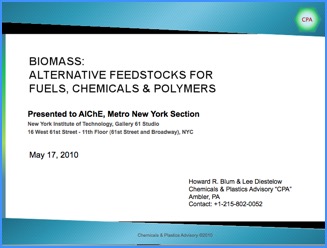
When: Monday, May 17th Where: NYIT's Gallery 61, Manhattan
• 12:45 - 1:30 pm - Biomass: Alternative Feedstocks for Fuels, Chemicals and Polymers 
Speaker: Howard Blum, Industry Consultant Bio Presentation
Biomass by its definition is a renewable energy source, derived from plants and organisms that can be converted into fuel for energy, chemicals and polymers. Most biomass of interest comes from trees, grasses and other plants, as well as the sea. Although fossil fuels do come from very ancient biomass sources, they are not considered biomass because they contain carbon that has been "out" of the carbon cycle for a very long time; fossil fuel emissions such as CO2 or CO are therefore “additive” to the overall content of atmospheric carbon gases and considered by many as an environmental problem.
Examples of fuels derived from biomass include wood chips, methane, ethanol and bio-diesel, which are currently used to supplement the use of fossil fuels. There are literally hundreds of biomass derived chemicals including bio-ethylene, propanediol, various polyols, surfactants and many types of specialties for personal care industry. There are also many types of biomass derived polymers, such as bio-polyethylene, polylactic acid (PLA), polyhydroxy alkanoate (PHA), epoxy resins, alkyd resins, regenerated cellulosics and many more.
Outside of the fuels markets, the global chemical industry, including commodities, specialties and polymers is estimated to exceed $3 trillion in sales. It enables many adjacent industries such as pharmaceuticals & healthcare, paints & coatings, adhesives, packaging, building products, soap & detergents and many more. Chemicals and polymers, combined with its adjacent end use sectors represent a broad and fertile potential for biomass derivatives.
Economically attractive biomass conversion, and therefore successful monetization of biomass feedstock and its derivatives, are partly based on the competitive price point for using competitive fossil fuels and derivatives, government legislation of laws that promote biomass conversion and the public’s interest to consume so-called “green” products.
Therefore, competitive technology and raw material sourcing will be key ingredients in achieving success in bio-derivatives. This presentation will provide a high-level review of the current trends in technology and markets for biomass feedstocks and the future outlook. It will focus on the integrated value chain for chemicals and polymers.
Back to Biomass Conference webpage


